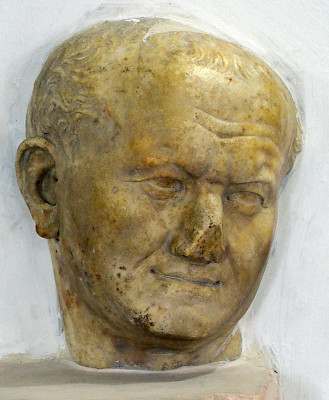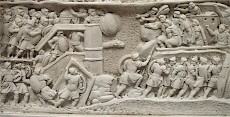Legio XVI Flavia Firma
Legio IIII Flavia Firma: one of the Roman legions. Its name means "the standfast Flavian legion".

The former legion XVI Gallica, which had been disgraced by its conduct during the Batavian revolt (69-70), was reconstituted by the emperor Vespasian under the name XVI Flavia Firmanote and transferred to the eastern provinces. This transfer was some sort of punishment, because the soldiers of XVI Gallica were from Gaul in the west. Yet the men must have been happy that they were not dishonorably discharged.
Vespasian was reorganizing the frontier along the Euphrates (for example, the old kingdom of Commagene was annexed), and the new legion was for some time stationed at Satala, on the Upper Euphrates, in the northeast of Cappadocia. It shared this section of the frontier, opposite Armenia, with XII Fulminata. There is hardly any evidence for this period in the legion's history.
The Sixteenth took part in the emperor Trajan's war against the Parthian empire (114-117), and was redeployed at Samosata by Trajan's successor Hadrian (117-138). It was a quiet period and it comes as no surprise to find only evidence for civil activities, like the building of a tunnel near Seleucia in Syria.
The Greek author Lucian, who was born in Samosata, describes the defeat of a Roman army in eastern Cappadocia in 161 by the hands of the Parthians. Perhaps VIIII Hispana was destroyed. We know that XVI Flavia Firma was among the troops used by the emperor Lucius Verus, when he retaliated and conquered Mesopotamia (the northern part of modern Iraq).

The Sixteenth must also have taken part in the two campaigns of Lucius Septimius Severus (194 and 197-198), which culminated in the capture of the Parthian capital Ctesiphon and the creation of a province Mesopotamia. Later, XVI Flavia Firma must have joined the easter campaign of Severus' son Caracalla, who died in 217 in nearby Harran.

One of the consequence of the creation of Mesopotamia was another reorganization of the Upper Euphrates area, which was no longer a threatened frontier zone. After all, two legions, I Parthica and III Parthica, were stationed farther to the east in the area between Euphrates and Tigris. During the reorganization of the old frontier zone, soldiers of the Sixteenth, from now on a strategic reserve, built a bridge across the river Chabinas, the modern Cendere Suya. This bridge is still in use and leads to the splendid mountain sanctuary at Nemrud Daği.
The sixteenth legion was still in this area during the reign of Severus Alexander and must have taken part in his campaign against the new, Sasanian Persian empire. The Sasanians had invaded the Roman empire in 230 and had installed an emperor in Emessa, but Severus Alexander was able to restore order and invade Mesopotamia. In 244, the Romans again invaded Iraq, but their emperor Gordian III died and was succeeded by Philippus Arabs, who owed his throne to the Sasanian king Shapur I. Even worse was to come.

In 256 Shapur captured Satala (the fortress of XV Apollinaris), and two years later he sacked Trapezus. When the Roman emperor Valerian tried to restore order and invaded Mesopotamia, he was defeated and captured. Captive Roman soldiers were ordered to build a bridge at modern Shushtar. These Roman defeats are commemorated on several Sasanian monuments.
However, under the emperors Odaenathus of Palmyra (261-267) and Diocletian (284-305), the Romans restored their fortunes and in 298, a peace treaty was concluded in which the Persians had to give up territories in northern Mesopotamia. The sixteenth legion must have played a role during these campaigns, but we have almost no information about them.
In the fourth century, the Sixteenth was still guarding the Euphrates, but had been transferred to Sura, which was downstream from Samosata.
The symbol of the Sixteenth, Flavian Legion was the lion.